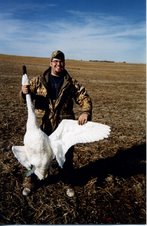
Every year the U.S. Fish and Wildlife service, and agencies ran by the states, place leg bands on a variety of birds across the country. Migratory birds, like ducks and geese, are some of the most commonly banded birds. Harvesting a bird with a leg band on it is a special joy for waterfowl hunters.
After harvesting a banded bird, most waterfowl hunters place the band on their lanyard, which holds the hunters duck and goose calls. “It’s like earning a buckeye sticker and putting it on your football helmet. It’s a badge of honor.” Explained Lyle Sinner, an avid waterfowl hunter and Fargo native.
Traditionally one must harvest a lot of ducks and geese before shooting a banded bird. Therefore, it is assumed that if a waterfowl hunter has a lot of bands, they have shot a lot of birds.
Some people can hunt their entire life and never shoot a bird that is banded. Other waterfowl hunters have shot quiet a few banded birds. It all depends on where you hunt and how many birds get banded in your area. However, you could potentially shoot a banded bird anytime, in any location.
The U.S. Fish and Wildlife service uses data reported from leg bands to track the flight paths of migratory birds. Bands are also useful in determining harvest information and life span data of specific bird species. A few years ago I witnessed my friend shoot a banded drake mallard that turned out to be 12 years old and was banded in North Dakota about 50 miles from where it was shot.
Each band has a unique number that identifies the species of bird and the specific information about it. When you call a band number in, an operator will ask for the date and location of where the bird was harvested. You will then receive a certificate in the mail containing your name and information on the banded bird.
Along with regular bands, the U.S. Fish and Wildlife service puts ‘reward bands’ on some birds. Usually they put these bands with a monetary value on adult birds. Reward bands are typically worth any where from 25 to 100 dollars. The government sends you a check only after you report the information regarding the banded bird to them. Getting paid to hunt, now that’s a nice bonus for anyone!
The U.S. Fish and Wildlife service are not the only ones that band birds. Some hunt clubs put leg bands on birds they release. Pheasants Forever, an organization for the preservation of pheasants, sometimes bands pheasants that they raise and release.
One of the rarer forms of waterfowl bands are Jack Miner bands. These bands have bible verses engraved on them. The Jack Miner family bands the birds in Ontario, Canada. It would be an incredible feat to shoot a duck or goose that was carrying a Jack Miner band.
Nicknames for leg bands are a common place among my friends and I. They are often referred to as: Jewelry, bling-bling, shine, hardware or leg irons. We refer to hunters who shoot a lot of banded birds as having “the force.”
Roughly 3.1 million leg bands have been reported to date. That is pretty small considering that since 1904 about 58 million birds have been banded in North America. Both of these numbers represent hundreds of different species of birds.
It has often been speculated in duck shacks and blinds across the country just what the ratio of banded birds to un-banded birds is. I have wondered this myself and have decided that there just isn’t any way to know for sure. Anyone could shoot a banded bird, and that is a beautiful thing.
Across North America roughly 85,000-banded birds are recovered or recorded annually. They make the hunt just a little bit more memorable and leave the hunter with a little souvenir. The first thing I do when I retrieve a harvested bird is check for a band. I encourage you to do the same. Band information can be reported to 1-800-327-BAND.





